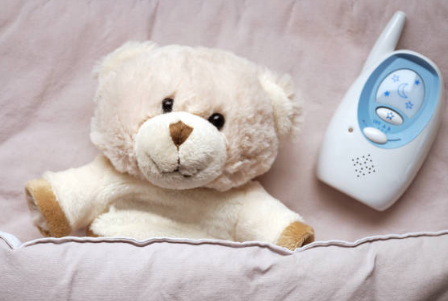As a new parent, it’s natural to want to keep an eye on your baby when they’re sleeping in another room. Baby monitors can provide parents and caregivers with peace of mind that you’re always on the lookout or listening to your baby. Nowadays, technology even allows you to monitor your baby while working, running errands, or even halfway across countries!
Let’s take a look at the types of baby monitors for new parents, which one might best suit your lifestyle and budget, what safety tips to keep in mind, and more.

Types of Baby Monitors
There are three basic types of baby monitors: audio monitors, video monitors, and WiFi-based monitors. All of this allows you to monitor your baby in different ways and can be helpful – it all depends on how much your budget allows, the features you are looking for, and your lifestyle.
Audio baby monitor
The audio monitor picks up any sounds your baby makes when they sleep or wake up. However, unlike video monitors, audio monitors don’t always tell you if your baby is just flipping and making noise during sleep, or if they’ve fully woken up.
Audio monitors are often the most budget-friendly option, though. If your baby will be sleeping in your room and you mainly monitor them during nap time or when you need to leave the bedroom, then an audio-only monitor may be what you need.
Video baby monitor
A video monitor allows you to see your baby’s entire sleep process. You usually mount the camera on the wall of your baby’s room, and most cameras offer special features like zoom, tilt, and night vision so that you can see your baby even when the lights are off.
You can also have multiple video receivers so you can monitor your baby in different parts of your home.
WiFi-based baby monitor
These types of monitors connect to your WiFi network so that you can see or hear your baby through your smartphone or other digital devices.
This means that you can continue to monitor your baby even when you’re away from home, which can be reassuring, especially when someone else is monitoring your little one or when you need to be separated from your baby for a while.
But keep in mind that a high-tech baby monitor isn’t necessary. Most baby monitors on the market work well to give you peace of mind.
Safety Tips for Using a Baby Monitor
In general, baby monitors are safe to use. However, some problems can arise if used incorrectly or without due diligence. Here are some baby monitor safety tips to keep in mind.
Follow the baby monitor cord safety guidelines
Since 2002, the U.S. Consumer Product Safety Commission (CPSC) has reported seven deaths related to baby monitor wires, and three incidents in which babies nearly choked on these lines.
For this reason, the CPSC recommends placing baby monitors with wires at least three feet away from the baby’s sleeping space, including cribs, bassints, or Pack ‘n Play. In addition, the U.S. Consumer Product Safety Commission recommends that baby monitors not be placed in or on the edge of a crib.

Consider expert guidance when it comes to respiratory monitors
There are baby monitors on the market that are designed to monitor your baby’s breathing to prevent sudden infant death syndrome (SIDS). However, the American Academy of Pediatrics (AAP) recommends against using these monitors in most cases.
The American Academy of Pediatrics (AAP) claims that these devices have not been shown to prevent sudden infant death syndrome (SIDS) and may be more concerning than anything else. However, if your baby has a known breathing problem or needs home oxygen, you and your healthcare provider can discuss the safe use of a sleep apnea monitor.
Never let a baby monitor replace human supervision
Baby monitors are indeed helpful, but they should not replace supervision by a parent or caregiver. If you haven’t seen your baby move or heard them cry in a while, be careful.
When your baby is not feeling well, it is important to check on your baby regularly, as the baby monitor will not detect fever or other details that only caregivers in the room can notice.
How to Set up a Baby Monitor
If possible, it’s a good idea to purchase and set up a monitor before welcoming your baby home. The reason is that every family is different, and some baby monitors are more likely to cause frequency interference than others.
If you’re using a video monitor, you’ll probably have it mounted on a wall, and you’ll need to make sure you choose a location that will allow you to fully capture your baby’s videos. The instructions that come with your specific device will give you more information on best practices, but be sure to follow the safety guidelines above regarding wire placement. You’ll also want to make sure that the baby monitor doesn’t pick up too much background noise, such as a fan or air conditioner.
When to Stop Using Your Baby Monitor
How long you choose to use a baby monitor is entirely up to you! Most parents use baby monitors for at least the first few months of their baby’s life, when babies often wake up at night. Some parents find these devices to be very useful for naps as well.
But many parents also end up using it in early childhood as well, as it helps to understand what your child is doing as they enter the crawl-out stage.
Still, some parents choose to abandon baby monitors altogether. This could be because their baby is sleeping in their room, or even because they find that the constant vigilance required for baby monitoring can be stressful for them. As long as you can hear your baby when they wake up, a baby monitor isn’t absolutely necessary. As with everything else in parenting, there is no one “right” way to complete this part of the journey.
